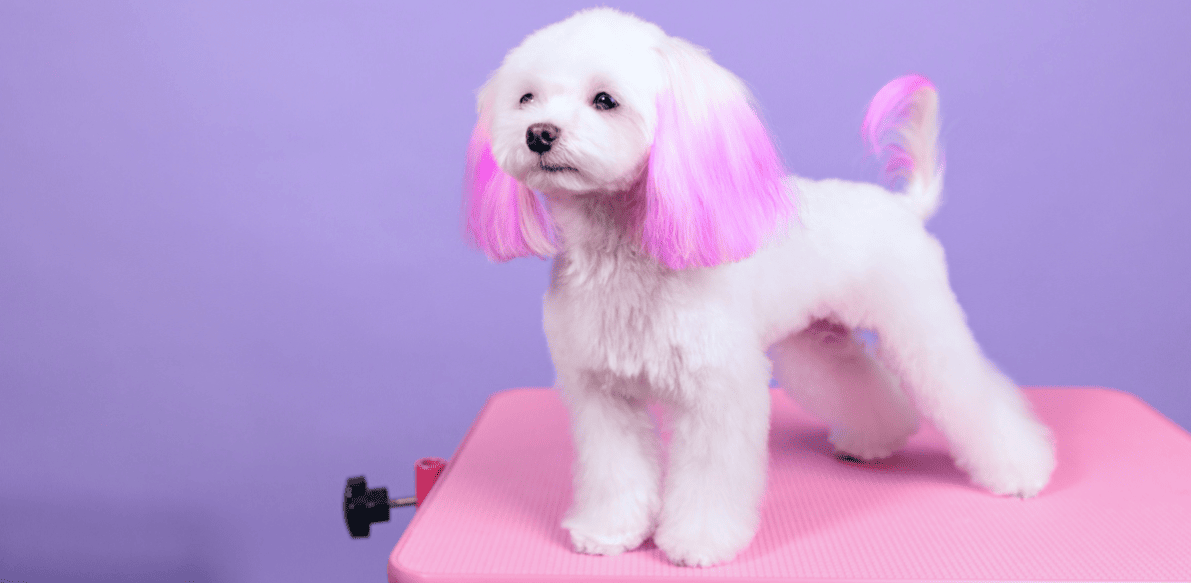Table of Contents
As pet owners, we love to shower our furry friends with love and attention. One fun way to express our creativity and add a touch of flair to our dog’s appearance is by dyeing their fur. Maybe you want your dog to show support for the local sports team or you want them to look festive at the next holiday party. Whatever the occasion, it’s essential to prioritize your dog’s well-being and safety above all else. We will discuss safe options for dyeing your dog’s hair and offer valuable tips to ensure the process is stress-free and enjoyable for both you and your canine companion.
Safe Dyeing Options
- Kool-Aid: Unsweetened Kool-Aid powder is a popular choice for temporary dog hair dyeing. It is non-toxic and comes in various vibrant colors, allowing you to experiment with different looks for your furry friend. Be sure to buy the sugar-free packets!
- Natural Food Coloring: Plant-based food coloring, such as beet juice, turmeric, or spinach extract, provides safe and temporary color for your dog’s fur. These options are generally gentle on the skin and non-harmful if accidentally ingested.
- Fur Chalk: Designed explicitly for pet hair coloring, fur chalk offers a safe and easy way to add temporary color to your dog’s fur. It is gentle and can be applied and removed with ease.
Tips for Dyeing Your Dog’s Fur
- Consult with a Professional: Before embarking on the dyeing process, consult with a professional groomer or your veterinarian. They can assess your dog’s coat type and overall health, providing valuable advice and potential alternatives if dyeing is not suitable for your dog.
- Perform a Patch Test: Even though the selected dyes are generally safe, it’s essential to perform a patch test on a small area of your dog’s fur before applying it all over. This helps identify any potential allergic reactions or sensitivities.
- Ensure a Calm Environment: Create a relaxing and comfortable environment for your dog during the dyeing process. Offer treats, toys, or gentle massages to keep your dog at ease and cooperative.
- Prepare the Fur: Before applying the dye, ensure your dog’s coat is clean and free of tangles or mats. Gently brush their fur to remove debris and achieve a smooth application.
- Use Appropriate Tools: Use soft brushes, sponges, or cotton balls to apply the dye, avoiding any contact with your dog’s eyes, ears, or mouth. Never use spray dyes, as they can be inhaled and pose health risks.
- Temporary Dyes Only: Stick to temporary dyes like Kool-Aid, natural food coloring, or fur chalk. Permanent hair dyes for humans contain chemicals that can harm your dog’s skin and health.
- Supervise Diligently: While dyeing your dog’s hair, supervise them closely to prevent them from licking or ingesting the dye. Some natural ingredients might still upset your dog’s stomach if ingested in large quantities.
Disadvantages of Dyeing Your Dog’s Fur
- Skin Sensitivity: Some dogs may have sensitive skin, making them more prone to irritation or allergic reactions from the dye. Always monitor your dog for any signs of discomfort.
- Stress and Anxiety: Not all dogs enjoy the dyeing process. Some may find it stressful and uncomfortable, leading to potential anxiety or behavioral issues.
- Ingestion Risk: Even though natural dyes are generally safe, accidental ingestion of large quantities might lead to digestive problems. It is essential to prevent your dog from licking or ingesting the dye during the process.
- Frequent Applications: If you frequently dye your dog’s fur, it can become burdensome for them, leading to potential coat and skin issues in the long run.
Dyeing your dog’s hair can be an exciting and creative way to express their personality and bond with your pet. By using safe and temporary options like Kool-Aid, natural food coloring, and fur chalk, and following the provided tips, you can ensure a positive experience for your canine companion. However, always prioritize your dog’s safety, health, and preferences above all else. Dyeing should be a rare and occasional treat rather than a regular practice. Remember that your dog’s well-being and happiness are paramount, and they will shine with or without colorful fur.

Emily is a veterinary technician with over 6 years of experience in the field. She knew since she was a child that she was meant to work with animals. She started her career working in veterinary ophthalmology and has since worked her way to general practice. Emily now works as a surgical technician working in the operating room. When not at work, Emily spends her time with her husband and her small zoo of 3 dogs, 4 cats, 5 ducks, and 5 chickens.








